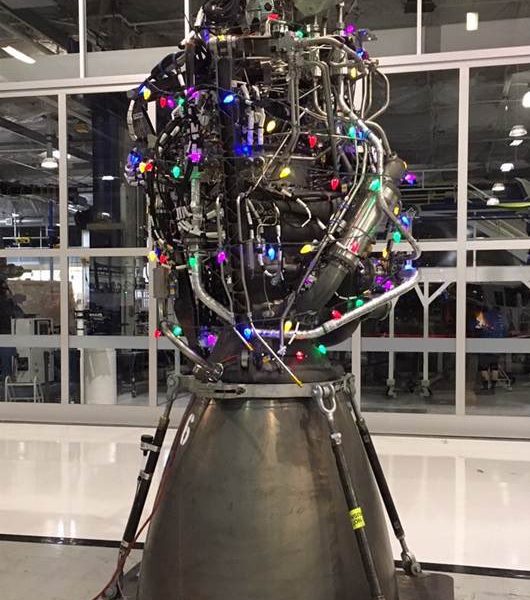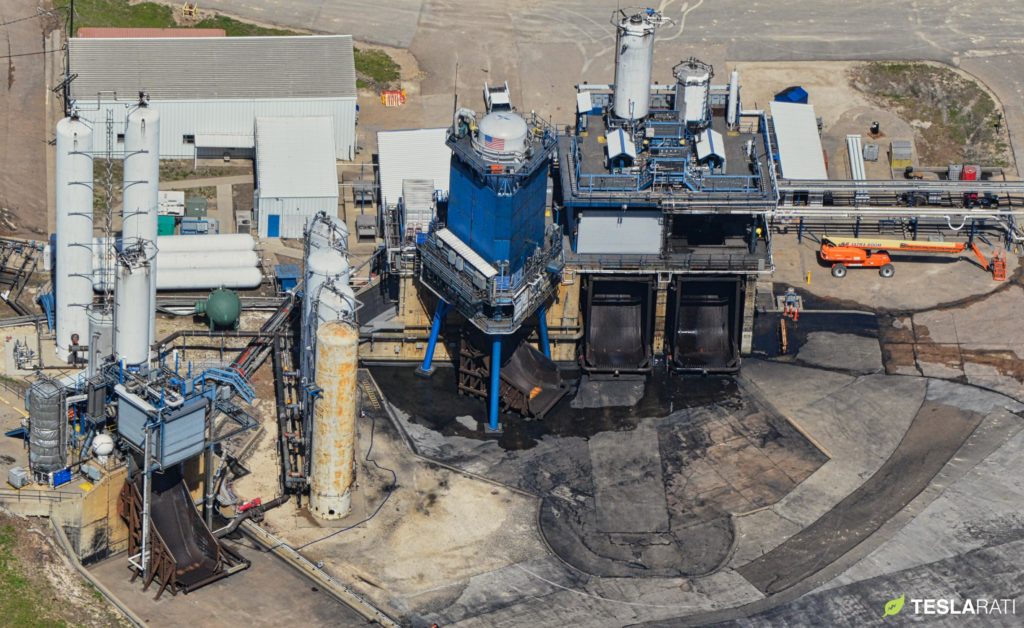

News
SpaceX's "Christmas tree" is a Raptor engine for the holidays
SpaceX CEO Elon Musk showed off a holiday-themed Raptor engine “Christmas tree” with its very own star on top. Musk noted via a tweet that the company’s Starship propulsion team is “making great progress” building, testing, and refining the Raptor engines that will one day propel the next-generation rocket to Earth orbit and beyond.
On December 13th, Musk revealed that SpaceX is preparing to ship the 17th completed Raptor engine to the company’s McGregor, Texas rocket test and development facilities, the site of several dedicated test stands for the Starship engine. Likely one of the most complex rocket engines ever designed, built, or tested, Raptor relies on an exotic combustion cycle, referring to the specifics of how engines turn their propellant into meaningful thrust.
Raptor uses what is known as full-flow staged combustion (FFSC) and is the first FFSC engine to graduate beyond ground testing and actually fly, thus far having completed two flight tests in July and August 2019 as part of SpaceX’s Starhopper test campaign. In simple terms, the FFSC cycle aims to extract as much energy from a rocket’s propellant as efficiently as possible, resulting in what is theoretically the most efficient possible chemical propulsion from a given fuel and oxidizer combination.
Due to the sheer complexity required to achieve full-flow staged combustion, the engine type is incredibly rare and only two other (once) functional examples exist – one developed by Soviet engineers in the 20th century and the other built, tested, and inexplicably scrapped by NASA in the 2000s. In fact, the Soviet RD-270 engine’s thrust-to-weight ratio is likely second only to SpaceX’s own Merlin 1D engine, an absolutely spectacular achievement for a propulsion bureau operating in the late 1960s.
RD-270 had major development challenges and would likely have taken years of additional hardware-rich (i.e. destructive trial and error) testing to produce an engine actually capable of reliable flight. Before the program was cancelled in 1970, 22 engines were tested and no single RD-270 survived to perform a fourth static fire, a testament to the immense challenge of FFSC engines.

SpaceX appears to have had a much better go of it with Raptor, although many, many engines have definitely been destroyed or irreparably damaged since the full-scale engine’s February 2019 static fire debut. SpaceX CEO Elon Musk says that the 17th completed Raptor engine is almost ready to head to McGregor, Texas to kick off development and acceptance testing.
It remains to be seen when exactly Raptor engines will be mature and reliable enough to perform the 3-10 minute burns needed to send a Starship to orbit, let alone the Moon or Mars, but Musk appears confident that SpaceX is making great progress along those lines.
Per photos and info posted by NASASpaceflight.com earlier today, Raptor engine SN15 is already installed on a recently-reactivated McGregor test stand ahead of its first rocket-related test in almost half a decade.
Formerly used to test Falcon 9 first stages before SpaceX built a new stand for Falcon 9 and Heavy, that tripod stand has been reactivated for the sole purpose of supporting vertical Raptor engine static fire testing, which Musk says will simplify and expedite development by making test conditions much more flight-like. As of now, all subscale and full-scale Raptor engine static fire testing has been performed at horizontal test stands in McGregor, apparently resulting in wear and behavior that would not likely appear if engines were tested vertically.
SpaceX has gone through the same process with its Merlin engine programs, beginning with horizontal testing (far easier and simpler) but ultimately building a number of dedicated vertical test bays to ensure that engine acceptance and development tests can be performed under more flight-like conditions.

According to NASASpaceflight, SpaceX may have already fired up Raptor SN15 on its reactivated tripod test stand earlier this week, kicking off Raptor’s first Starhopper-free vertical static fire testing. It’s now unclear where the twin horizontal Raptor test bays will fit into future engine testing given Musk’s comments. More importantly, every completed Starship and Super Heavy rocket will require several dozen new Raptor engines and every one of those engines will likely need to pass acceptance testing (including static fires) in McGregor before they can be installed on a launch vehicle.
SpaceX’s Falcon 9 rocket already requires 10 engines per new booster and upper stage, a test burden SpaceX has only managed with the help of two Merlin 1D stands and one Merlin Vacuum stand, all vertical. In other words, it’s safe to say that the reactivated tripod stand is likely just the first of several vertical Raptor test stands to come.

Check out Teslarati’s Marketplace! We offer Tesla accessories, including for the Tesla Cybertruck and Tesla Model 3.

Elon Musk
Elon Musk confirms xAI’s purchase of five 380 MW natural gas turbines
The deal, which was confirmed by Musk on X, highlights xAI’s effort to aggressively scale its operations.

xAI, Elon Musk’s artificial intelligence startup, has purchased five additional 380 MW natural gas turbines from South Korea’s Doosan Enerbility to power its growing supercomputer clusters.
The deal, which was confirmed by Musk on X, highlights xAI’s effort to aggressively scale its operations.
xAI’s turbine deal details
News of xAI’s new turbines was shared on social media platform X, with user @SemiAnalysis_ stating that the turbines were produced by South Korea’s Doosan Enerbility. As noted in an Asian Business Daily report, Doosan Enerbility announced last October that it signed a contract to supply two 380 MW gas turbines for a major U.S. tech company. Doosan later noted in December that it secured an order for three more 380 MW gas turbines.
As per the X user, the gas turbines would power an additional 600,000+ GB200 NVL72 equivalent size cluster. This should make xAI’s facilities among the largest in the world. In a reply, Elon Musk confirmed that xAI did purchase the turbines. “True,” Musk wrote in a post on X.
xAI’s ambitions
Recent reports have indicated that xAI closed an upsized $20 billion Series E funding round, exceeding the initial $15 billion target to fuel rapid infrastructure scaling and AI product development. The funding, as per the AI startup, “will accelerate our world-leading infrastructure buildout, enable the rapid development and deployment of transformative AI products.”
The company also teased the rollout of its upcoming frontier AI model. “Looking ahead, Grok 5 is currently in training, and we are focused on launching innovative new consumer and enterprise products that harness the power of Grok, Colossus, and 𝕏 to transform how we live, work, and play,” xAI wrote in a post on its website.
Elon Musk
Elon Musk’s xAI closes upsized $20B Series E funding round
xAI announced the investment round in a post on its official website.

xAI has closed an upsized $20 billion Series E funding round, exceeding the initial $15 billion target to fuel rapid infrastructure scaling and AI product development.
xAI announced the investment round in a post on its official website.
A $20 billion Series E round
As noted by the artificial intelligence startup in its post, the Series E funding round attracted a diverse group of investors, including Valor Equity Partners, Stepstone Group, Fidelity Management & Research Company, Qatar Investment Authority, MGX, and Baron Capital Group, among others.
Strategic partners NVIDIA and Cisco Investments also continued support for building the world’s largest GPU clusters.
As xAI stated, “This financing will accelerate our world-leading infrastructure buildout, enable the rapid development and deployment of transformative AI products reaching billions of users, and fuel groundbreaking research advancing xAI’s core mission: Understanding the Universe.”
xAI’s core mission
Th Series E funding builds on xAI’s previous rounds, powering Grok advancements and massive compute expansions like the Memphis supercluster. The upsized demand reflects growing recognition of xAI’s potential in frontier AI.
xAI also highlighted several of its breakthroughs in 2025, from the buildout of Colossus I and II, which ended with over 1 million H100 GPU equivalents, and the rollout of the Grok 4 Series, Grok Voice, and Grok Imagine, among others. The company also confirmed that work is already underway to train the flagship large language model’s next iteration, Grok 5.
“Looking ahead, Grok 5 is currently in training, and we are focused on launching innovative new consumer and enterprise products that harness the power of Grok, Colossus, and 𝕏 to transform how we live, work, and play,” xAI wrote.
Investor's Corner
Tesla gets price target bump, citing growing lead in self-driving

Tesla (NASDAQ: TSLA) stock received a price target update from Pierre Ferragu of Wall Street firm New Street Research, citing the company’s growing lead in self-driving and autonomy.
On Tuesday, Ferragu bumped his price target from $520 to $600, stating that the consensus from the Consumer Electronics Show in Las Vegas was that Tesla’s lead in autonomy has been sustained, is growing, and sits at a multiple-year lead over its competitors.
CES 2026 validates Tesla’s FSD strategy, but there’s a big lag for rivals: analyst
“The signal from Vegas is loud and clear,” the analyst writes. “The industry isn’t catching up to Tesla; it is actively validating Tesla’s strategy…just with a 12-year lag.”
The note shows that the company’s prowess in vehicle autonomy is being solidified by lagging competitors that claim to have the best method. The only problem is that Tesla’s Vision-based approach, which it adopted back in 2022 with the Model 3 and Model Y initially, has been proven to be more effective than competitors’ approach, which utilizes other technology, such as LiDAR and sensors.
Currently, Tesla shares are sitting at around $433, as the company’s stock price closed at $432.96 on Tuesday afternoon.
Ferragu’s consensus on Tesla shares echoes that of other Wall Street analysts who are bullish on the company’s stock and position within the AI, autonomy, and robotics sector.
Dan Ives of Wedbush wrote in a note in mid-December that he anticipates Tesla having a massive 2026, and could reach a $3 trillion valuation this year, especially with the “AI chapter” taking hold of the narrative at the company.
Ives also said that the big step in the right direction for Tesla will be initiating production of the Cybercab, as well as expanding on the Robotaxi program through the next 12 months:
“…as full-scale volume production begins with the autonomous and robotics roadmap…The company has started to test the all-important Cybercab in Austin over the past few weeks, which is an incremental step towards launching in 2026 with important volume production of Cybercabs starting in April/May, which remains the golden goose in unlocking TSLA’s AI valuation.”
Tesla analyst breaks down delivery report: ‘A step in the right direction’
Tesla has transitioned from an automaker to a full-fledged AI company, and its Robotaxi and Cybercab programs, fueled by the Full Self-Driving suite, are leading the charge moving forward. In 2026, there are major goals the company has outlined. The first is removing Safety Drivers from vehicles in Austin, Texas, one of the areas where it operates a ride-hailing service within the U.S.
Ultimately, Tesla will aim to launch a Level 5 autonomy suite to the public in the coming years.








